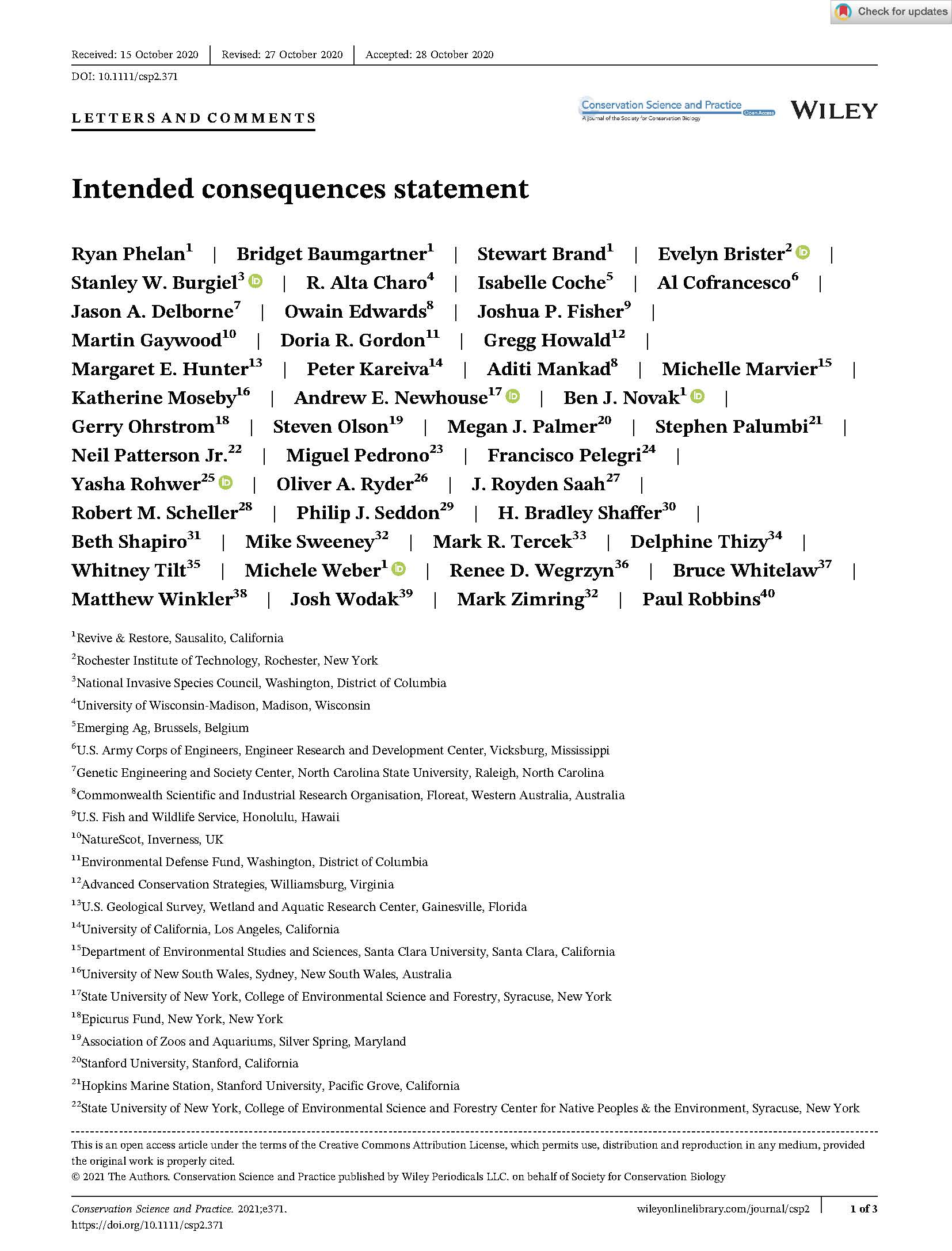Participants in discussion during the Intended Consequences workshop.
INTENDED CONSEQUENCES STATEMENT
This statement is published in the Intended Consequences special issue of Conservation Science and Practice.
It was co-authored by 46 participants of the Intended Consequences workshop held by Revive & Restore in June 2020.
INTENDED CONSEQUENCES STATEMENT
As the biodiversity crisis accelerates, the stakes are higher for threatened plants and animals. Rebuilding the health of our planet will require addressing underlying threats at many scales, including habitat loss and climate change. Conservation interventions such as habitat protection, management, restoration, predator control, translocation, genetic rescue, and biological control have the potential to help threatened or endangered species avert extinction. These existing, well-tested methods can be complemented and augmented by more frequent and faster adoption of new technologies, such as powerful new genetic tools. In addition, synthetic biology might offer solutions to currently intractable conservation problems. We believe that conservation needs to be bold and clear-eyed in this moment of great urgency.
Proposed efforts to mitigate conservation threats often raise concerns about potentially harmful unintended consequences. For some highly documented strategies based on conservation principles, such as biological control, conservation translocations, and restoration of natural fire regimes, evidence to date suggests that careful planning produces the intended consequences while avoiding adverse unintended consequences. For example, better identification and mitigation of risks has resulted in no severe, negative, unintended consequences for conservation translocations and biological control releases over the last forty years in the United States (Novak et al. submitted).
This progress, especially after the well-publicized harmful interventions from the early history of the field, has been made by improving conservation intervention techniques, scientific understanding of dynamic interactions in complex ecosystems, and early stakeholder engagement. The substantial history of intervention should encourage us to thoughtfully pursue novel approaches to conservation as the technology advances, focusing on the future we want, rather than being daunted by the future we fear.
In June 2020, Revive & Restore convened a group of 57 conservationists, wildlife biologists, restoration specialists, conservation geneticists, ethicists, and social scientists to propose a new framework for the future of conservation, focused on intended consequences. There was broad consensus that developing and employing what might be considered controversial genetic technologies will require a commitment to responsible decision-making that respects the diversity of perspectives, interests, and values among different stakeholders. To encourage working confidently with emerging tools and technologies, we propose a framework that increases inclusivity and embraces conservation innovation.
The participants of the Intended Consequences Workshop agree that:
- Conservationists and other stakeholders should codesign conservation interventions to advance biodiversity goals and achieve intended consequences.
- A broader definition of risk and the development of new risk assessment tools will facilitate appropriate risk identification and mitigation during intervention planning and implementation.
- Inaction and delay also incur consequences. The risks of inaction must also be identified and taken into consideration.
- Being transparent about social and cultural values is essential to success because science alone cannot tell us what we should do.
- Inclusive engagement with communities and stakeholders, including indigenous peoples and marginalized groups, allows for a thoughtful exploration of diverse visions for future ecosystems and the path to a vibrant and resilient nature.
- A code of practice for genetic interventions that weighs ecological and social risks, and potential benefits, will help conservationists, funders and the public make informed decisions for responsible and innovative action.
- The code of practice should evolve with new knowledge, additional experience, and further deliberation via an inclusive process.
- Monitoring results, both positive and negative, will help conservationists design successful interventions, manage uncertainty, and codify lessons learned along the way.
These initial points of agreement, along with an evolving code of practice, can help guide future conservation interventions and inspire confidence in our ability to design for and achieve intended consequences.
The findings and conclusions in this article are those of the author(s) and do not necessarily represent the views of: the U.S. Fish and Wildlife Service, CSIRO, NatureScot, Imperial College London, San Diego Zoo Wildlife Alliance, and National Invasive Species Council.
*The Intended Consequences Statement by Ryan Phelan et al., is licensed under Creative Commons by Wiley (CC BY). Co-authors are listed here in the same order as in the journal.
THE CO-AUTHORS*
- Ryan Phelan—Revive & Restore
- Bridget Baumgartner—Revive & Restore
- Stewart Brand—Revive & Restore
- Evelyn Brister—Rochester Institute of Technology
- Stanley W. Burgiel—National Invasive Species Council
- R. Alta Charo—University of Wisconsin-Madison
- Isabelle Coche—Emerging Ag
- Al Cofrancesco—U.S. Army Engineer Research and Development Center
- Jason A. Delborne—North Carolina State University
- Owain Edwards—Commonwealth Scientific and Industrial Research Organisation
- Joshua P. Fisher—U.S. Fish and Wildlife Service
- Martin Gaywood—NatureScot
- Doria R. Gordon—Environmental Defense Fund
- Gregg Howald—Advanced Conservation Strategies and Coastal Conservation
- Margaret E. Hunter—U.S. Geological Survey, Wetland & Aquatic Research Center
- Peter Kareiva—University of California, Los Angeles
- Aditi Mankad—Commonwealth Scientific and Industrial Research Organisation
- Michelle Marvier—Santa Clara University
- Katherine Moseby—University of New South Wales
- Andrew E. Newhouse—State University of New York
- Ben J. Novak—Revive & Restore
- Gerry Ohrstrom—Epicurus Fund
- Steve Olson—Association of Zoos & Aquariums
- Megan J. Palmer—Stanford University
- Stephen Palumbi—Stanford University
- Neil Patterson, Jr.—State University of New York
- Miguel Pedrono—French Agricultural Research Centre for International Development
- Francisco Pelegri—University of Wisconsin-Madison
- Yasha Rohwer—Oregon Institute of Technology
- Oliver A. Ryder—San Diego Zoo Global
- J. Royden Saah—Island Conservation
- Robert M. Scheller—North Carolina State University
- Philip J. Seddon—University of Otago
- H. Bradley Shaffer—University of California, Los Angeles
- Beth Shapiro—University of California, Santa Cruz
- Mike Sweeney—The Nature Conservancy
- Mark R. Tercek—Environmentalist
- Delphine Thizy—Imperial College London
- Whitney Tilt—Conservation Benchmarks
- Michele Weber—Revive & Restore
- Renee D. Wegrzyn—Ginkgo Bioworks
- Bruce Whitelaw—The Roslin Institute
- Matthew Winkler—Asuragen
- Josh Wodak—Western Sydney University
- Mark Zimring—The Nature Conservancy
- Paul Robbins—University of Wisconsin-Madison




